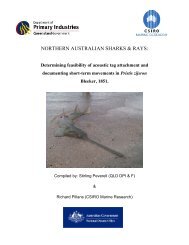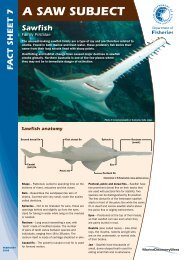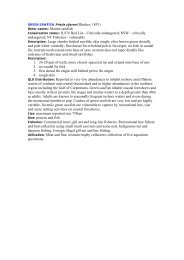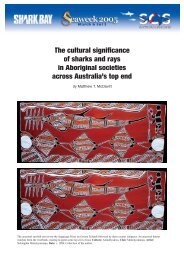September 2005 - Marine Education Society of Australasia
September 2005 - Marine Education Society of Australasia
September 2005 - Marine Education Society of Australasia
Create successful ePaper yourself
Turn your PDF publications into a flip-book with our unique Google optimized e-Paper software.
It was very exciting to meet some <strong>of</strong> the<br />
scientists whose work I had heard about and<br />
to hear about some <strong>of</strong> the amazing projects<br />
that are underway all around Australia.<br />
Below are summaries <strong>of</strong> some <strong>of</strong> the<br />
presentations.<br />
Ocean Acidification<br />
Dr Steve Widdicombe, Plymouth <strong>Marine</strong> Lab,<br />
UK<br />
During pre-industrial times, the oceans and<br />
the organisms within them contained<br />
approximately 38,000 gigatonnes (Gt) <strong>of</strong><br />
CO 2 . In the last 200 years <strong>of</strong><br />
industrialisation human activities have<br />
released 6 Gt <strong>of</strong> CO 2 into the atmosphere,<br />
about 48% <strong>of</strong> which has been absorbed by<br />
the oceans.<br />
CO 2 dissolves into seawater to form<br />
dissolved inorganic carbon, consisting <strong>of</strong>:<br />
• Aqueous CO 2 (including carbonic<br />
acid) – 1%<br />
• Bicarbonate (HCO 3 ) – 91%<br />
• Carbonate CO 3 - 8%<br />
Currently the oceans are slightly alkaline,<br />
with a pH <strong>of</strong> 8.1 ± 0.3. Oceanic pH has<br />
decreased by 0.1 pH units since preindustrial<br />
times, this is equivalent to a 30%<br />
increase in hydrogen ions in the last 200<br />
years.<br />
A decrease in pH causes:<br />
• A decrease in carbonate ions;<br />
• An increase in carbonic acid; and<br />
• An increase in bicarbonate.<br />
Calcium carbonate (which many sea<br />
creatures use for building shells, etc.) will<br />
dissolve unless there is a sufficiently high<br />
concentration <strong>of</strong> carbonate ions in the water.<br />
Calcium carbonate becomes more soluble<br />
with a decrease in temperature and an<br />
increase in pressure – so the deeper the<br />
water the more likely calcium carbonate is to<br />
become soluble.<br />
50% <strong>of</strong> the global primary production is<br />
carried out by plankton that is less than 10<br />
micrometres in size. It was once proposed<br />
that an increase in CO 2 would assist global<br />
primary production, especially in the oceans,<br />
however it is now known that CO 2 is not a<br />
limiting factor for most marine algae.<br />
Effects on larger organisms include a<br />
decrease in both motility and fertility. The<br />
impacts on fish and squid includes<br />
hypercapnia – this is a condition <strong>of</strong> too much<br />
CO 2 in the blood. A decrease in oceanic pH<br />
will affect their ability to assimilate oxygen<br />
and they will have problems getting rid <strong>of</strong><br />
excess CO 2 , which will build up in their blood<br />
to cause hypercapnia.<br />
Coccolithophores are a beautiful singlecelled<br />
form <strong>of</strong> microscopic sealife that use<br />
calcium carbonate to build shells (called<br />
‘liths’) around their cell. The effects <strong>of</strong> a<br />
decrease in pH under experimental<br />
conditions produced reduced numbers <strong>of</strong><br />
coccolithophores, reduced quality <strong>of</strong> liths<br />
and a reduction in the number <strong>of</strong> liths per<br />
cell.<br />
The impacts will also reach down to<br />
cold/deep water corals. Some <strong>of</strong> these<br />
colonies are up to 8000 years old!<br />
The economic impacts <strong>of</strong> reduced pH are<br />
huge. It has been estimated that since the<br />
1980s, approximately 30% <strong>of</strong> tropical corals<br />
have disappeared and more are to go. Coral<br />
loss equals financial loss. In the most<br />
dependent region <strong>of</strong> north Queensland, <strong>of</strong><br />
$900 mlln revenue, $800 mlln is associated<br />
with healthy coral reefs. Degradation <strong>of</strong><br />
those reefs will cost the local economies<br />
about $2.5 billion over the 19 years from<br />
2001 to 2020.<br />
The oceans currently take up to 1 tonne <strong>of</strong><br />
human-derived CO 2 per year for each person<br />
on the planet. Ocean acidification is a<br />
predictable response and one about which we<br />
can do nothing. Even if we were to stop<br />
producing CO 2 right now, ocean pH will<br />
continue to decrease for several decades<br />
yet.<br />
Customs<br />
In southern Australian waters, the vessel<br />
Southern Supporter is a joint<br />
fisheries/customs ship that targets illegal<br />
fishers taking Patagonian and Antarctic<br />
toothfish. These are deepwater fish, living<br />
up to 50 years and fetching up to US<br />
30










